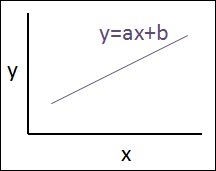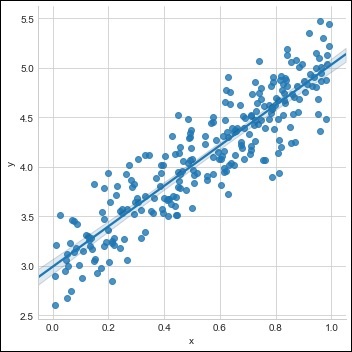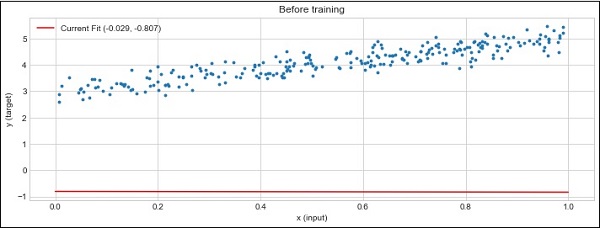📌 相关文章
- PyTorch线性回归(1)
- PyTorch线性回归
- 使用PyTorch进行线性回归
- 使用PyTorch进行线性回归(1)
- R线性回归(1)
- R-线性回归(1)
- 线性回归 (1)
- R-线性回归
- R线性回归
- python中的线性回归(1)
- Python线性回归(1)
- Python线性回归
- python代码示例中的线性回归
- 线性回归 - Javascript 代码示例
- 线性回归 - 无论代码示例
- 回归算法-线性回归(1)
- 回归算法-线性回归
- python 线性回归 - Python (1)
- TensorFlow中的线性回归
- TensorFlow-线性回归
- TensorFlow-线性回归(1)
- TensorFlow中的线性回归(1)
- Python中的单变量线性回归
- Python中的单变量线性回归(1)
- python 线性回归 - Python 代码示例
- 线性回归(Python实现)
- 线性回归(Python实现)
- 线性回归(Python实现)(1)
- 统计-线性回归
📜 PyTorch-线性回归
📅 最后修改于: 2020-12-10 05:23:08 🧑 作者: Mango
在本章中,我们将重点介绍使用TensorFlow实现线性回归的基本示例。 Logistic回归或线性回归是一种有监督的机器学习方法,用于对离散量类别进行分类。本章的目标是建立一个模型,用户可以通过该模型来预测预测变量和一个或多个自变量之间的关系。
这两个变量之间的关系被认为是线性的,即,如果y是因变量,而x被视为自变量,则两个变量的线性回归关系将看起来像下面提到的方程式-
Y = Ax+b
接下来,我们将设计用于线性回归的算法,该算法使我们能够理解下面给出的两个重要概念:
- 成本函数
- 梯度下降算法
线性回归的示意图如下
解释结果
$$ Y = ax + b $$
-
a的值是斜率。
-
b的值是y-截距。
-
r是相关系数。
-
r 2是相关系数。
下面提到线性回归方程的图形视图-

以下步骤用于使用PyTorch实现线性回归-
第1步
使用以下代码导入必要的包以在PyTorch中创建线性回归-
import numpy as np
import matplotlib.pyplot as plt
from matplotlib.animation import FuncAnimation
import seaborn as sns
import pandas as pd
%matplotlib inline
sns.set_style(style = 'whitegrid')
plt.rcParams["patch.force_edgecolor"] = True
第2步
使用可用数据集创建单个训练集,如下所示:
m = 2 # slope
c = 3 # interceptm = 2 # slope
c = 3 # intercept
x = np.random.rand(256)
noise = np.random.randn(256) / 4
y = x * m + c + noise
df = pd.DataFrame()
df['x'] = x
df['y'] = y
sns.lmplot(x ='x', y ='y', data = df)

第三步
使用PyTorch库实现线性回归,如下所述-
import torch
import torch.nn as nn
from torch.autograd import Variable
x_train = x.reshape(-1, 1).astype('float32')
y_train = y.reshape(-1, 1).astype('float32')
class LinearRegressionModel(nn.Module):
def __init__(self, input_dim, output_dim):
super(LinearRegressionModel, self).__init__()
self.linear = nn.Linear(input_dim, output_dim)
def forward(self, x):
out = self.linear(x)
return out
input_dim = x_train.shape[1]
output_dim = y_train.shape[1]
input_dim, output_dim(1, 1)
model = LinearRegressionModel(input_dim, output_dim)
criterion = nn.MSELoss()
[w, b] = model.parameters()
def get_param_values():
return w.data[0][0], b.data[0]
def plot_current_fit(title = ""):
plt.figure(figsize = (12,4))
plt.title(title)
plt.scatter(x, y, s = 8)
w1 = w.data[0][0]
b1 = b.data[0]
x1 = np.array([0., 1.])
y1 = x1 * w1 + b1
plt.plot(x1, y1, 'r', label = 'Current Fit ({:.3f}, {:.3f})'.format(w1, b1))
plt.xlabel('x (input)')
plt.ylabel('y (target)')
plt.legend()
plt.show()
plot_current_fit('Before training')
生成的图如下-
